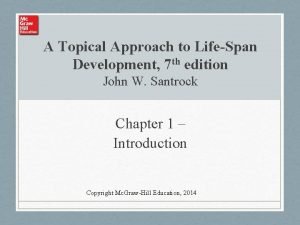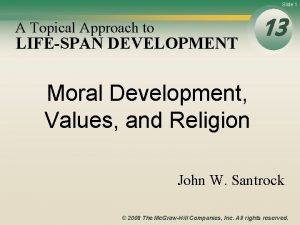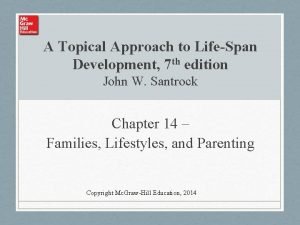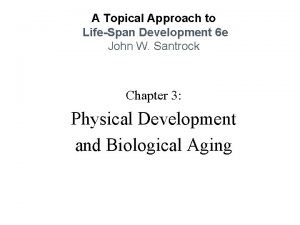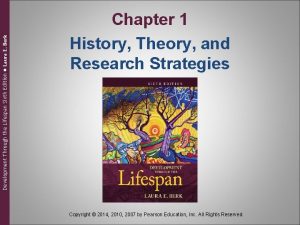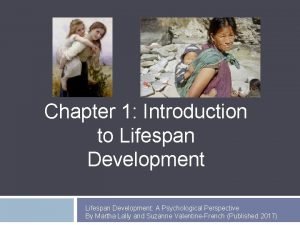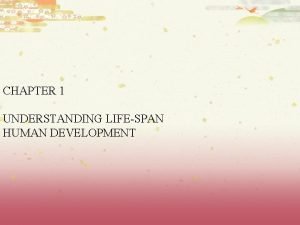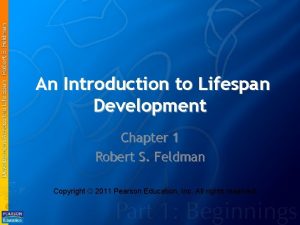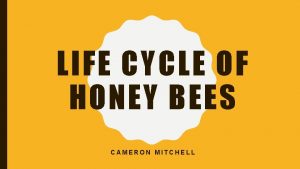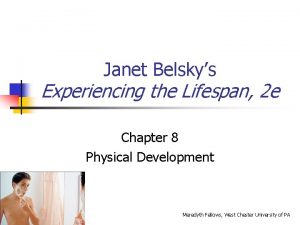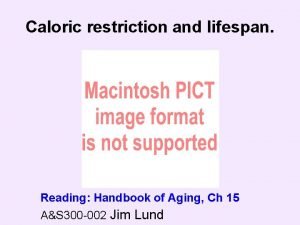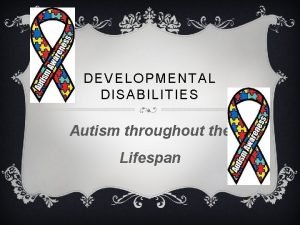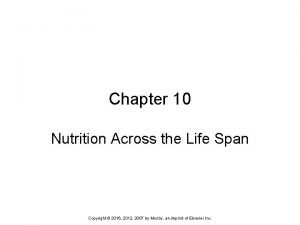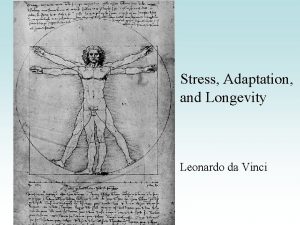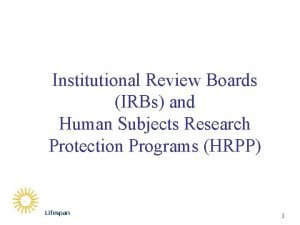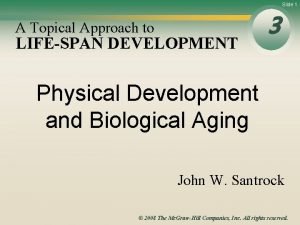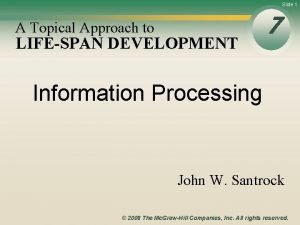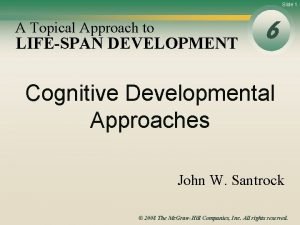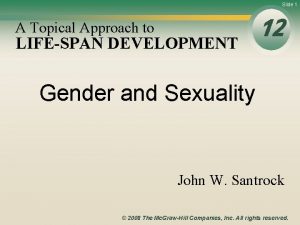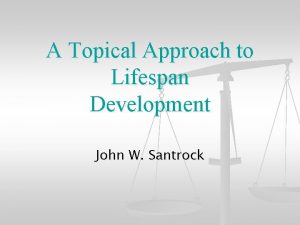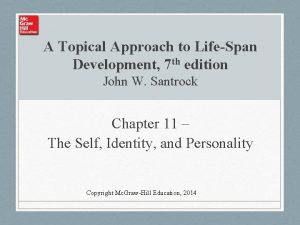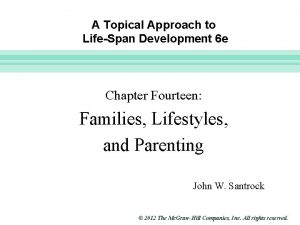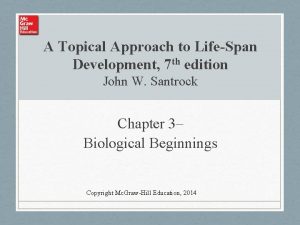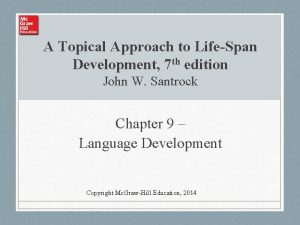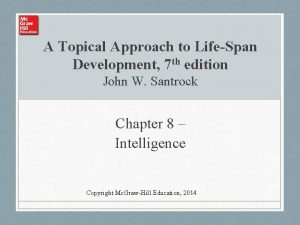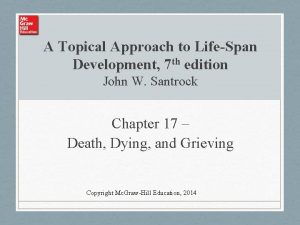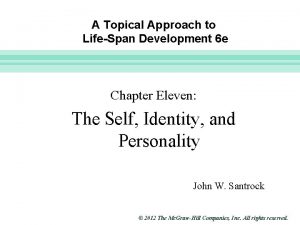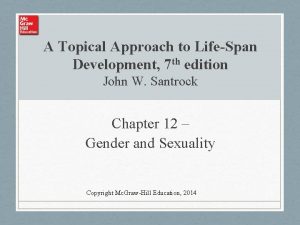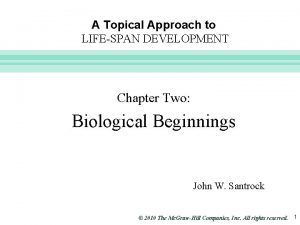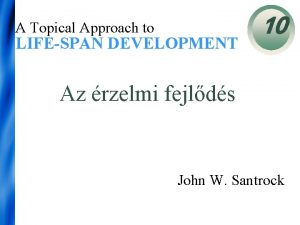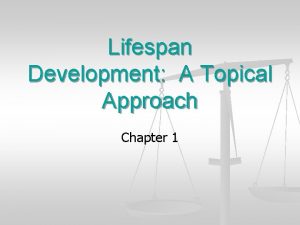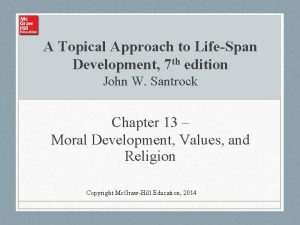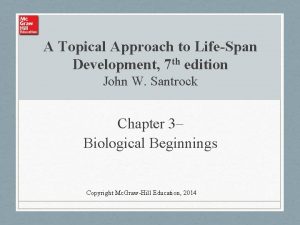A Topical Approach to LifeSpan Development 7 th




























- Slides: 28

A Topical Approach to Life-Span Development, 7 th edition John W. Santrock Chapter 6 – Cognitive Development Approaches Copyright Mc. Graw-Hill Education, 2014

Piaget’s Theory of Cognitive Development • Piaget’s theory stresses that children actively construct their own knowledge of the world • Create mental structures to help us adapt to our world • Discusses systematic changes in children’s thinking • Processes of development: • Schemes • Actions or mental representations that organize knowledge • Assimilation • Children use existing schemes to incorporate new information • Accommodation • Adjusting schemes to fit new information and experiences Copyright Mc. Graw-Hill Education, 2014

Piaget’s Theory of Cognitive Development Copyright Mc. Graw-Hill Education, 2014

Piaget’s Theory of Cognitive Development • Sensorimotor Stage: • Lasts from birth to 2 years • Infants construct an understanding of world by coordinating sensory experiences (such as seeing and hearing) with physical, motor actions • 6 Substages: • Simple reflexes • First month after birth • Sensation and action are coordinated through reflexive behaviors • Infant begins to produce behaviors that resemble reflexes in absence of the usual stimulus Copyright Mc. Graw-Hill Education, 2014

Piaget’s Theory of Cognitive Development Copyright Mc. Graw-Hill Education, 2014

Piaget’s Theory of Cognitive Development • Object permanence • Understanding that objects continue to exist even when they cannot be seen, heard, or touched • Important accomplishment made during first year of infancy Copyright Mc. Graw-Hill Education, 2014

Piaget’s Cognitive Development Theory • Preoperational Stage • Lasts from approximately 2 to 7 years of age • Children begin to represent the world with words, images, drawings • Form stable concepts and begin to reason • Do not yet have understanding of operations • Reversible mental actions that allow children to do mentally what before they could only do physically Copyright Mc. Graw-Hill Education, 2014

Piaget’s Cognitive Development Theory • Symbolic function substage • Occurs between ages 2 to 4 • Child gains the ability to mentally represent an object that is not present • Scribble designs to represent people, houses, cars, etc. • Use language and engage in pretend play Copyright Mc. Graw-Hill Education, 2014

Piaget’s Cognitive Development Theory • Egocentrism • Inability to distinguish between one’s own perspective and someone else’s perspective • Preschool children often show the ability to take another’s perspective on some tasks but not others • Animism • Belief that inanimate objects have lifelike qualities and are capable of action • Failure to distinguish between appropriate occasions for human and nonhuman perspectives Copyright Mc. Graw-Hill Education, 2014

Piaget’s Cognitive Development Theory • Intuitive thought substage • Second substage of preoperational thought • Between ages 4 to 7 years old • Children use primitive reasoning and want to know the answers to all sorts of questions • “Why? ” questions signal emergence of interest in figuring out why things are the way they are Copyright Mc. Graw-Hill Education, 2014

Piaget’s Cognitive Development Theory • Centration • Focusing of attention on one characteristic to the exclusion of all others • Conservation • Awareness that altering the appearance of an object or substance does not change its basic properties • Conservation may appear earlier than Piaget thought • Attention is especially important in explaining conservation Copyright Mc. Graw-Hill Education, 2014

Piaget’s Cognitive Development Theory Copyright Mc. Graw-Hill Education, 2014

Piaget’s Cognitive Development Theory • Concrete operational stage • Lasts from approximately 7 to 11 years of age • Children can perform concrete operations and logical reasoning as long as it can be applied to specific or concrete examples • Concrete operations allow a child to consider several characteristics rather than to focus on a single property of an object Copyright Mc. Graw-Hill Education, 2014

Piaget’s Cognitive Development Theory • New skills at concrete operational stage: • Classify and divide into different sets or subsets • Consider interrelationships among objects • Capable of seriation • Ability to order stimuli along a quantitative dimension (such as length) • Transitivity • Ability to logically combine relations to understand certain conclusions Copyright Mc. Graw-Hill Education, 2014

Piaget’s Cognitive Development Theory • Formal operational stage • Appears between 11 to 15 years of age • Begin to think in abstract, more logical ways • Develop images of ideal circumstances • Deductive reasoning • Develop hypotheses, or best guesses, and systematically deduce which is the best path to follow in solving the problem Copyright Mc. Graw-Hill Education, 2014

Piaget’s Cognitive Development Theory • Adolescent egocentrism • Heightened self-consciousness of adolescents • Reflected in beliefs that others are as interested in them as they themselves are • Imaginary audience • Feeling one is the center of attention and sensing one is on stage • Personal fable • Sense of personal uniqueness and invincibility Copyright Mc. Graw-Hill Education, 2014

Applying and Evaluating Piaget’s Theory • Piaget’s theory applied to teaching children: • Take a constructivist approach • Children learn best when active and seeking solutions for themselves • Facilitate rather than direct learning • Design situations where students learn by doing • Consider child’s knowledge, level of thinking • Teachers need to interpret what students are saying and respond in a way not too far from student’s level • Important to examine children’s mistakes to help guide to a higher level of understanding Copyright Mc. Graw-Hill Education, 2014

Applying Piaget’s Theory • What should a Piagetian Classroom look like? Copyright Mc. Graw-Hill Education, 2014

Evaluating Piaget’s Theory • Some cognitive abilities emerge earlier than Piaget estimated • Other cognitive abilities emerge later than Piaget’s ideas • Many adolescents still think in concrete operational ways or are just beginning to master formal operations • Many adults are not formal operational thinkers • Children can be trained to reason at a higher cognitive stage • Culture and education exerts stronger influence than Piaget maintained • Neo-Piagetians argue for more emphasis on how children use attention, memory, and strategies to process information Copyright Mc. Graw-Hill Education, 2014

Vygotsky’s Theory of Cognitive Development • Vygotsky also emphasized that children actively construct their knowledge and understanding • Emphasized the role of the social environment in stimulating cognitive development • Society provides tools to support cognitive development • Cognitive development is shaped by cultures in which we live Copyright Mc. Graw-Hill Education, 2014

Vygotsky’s Theory of Cognitive Development • Zone of proximal development (ZPD) • Range of tasks that are too difficult for children to master alone but can be mastered with guidance and assistance from adults or more-skilled children • Lower limit of ZPD is level of skill reached by child working independently • Upper limit of ZPD includes additional responsibility child can accept with assistance of an able instructor Copyright Mc. Graw-Hill Education, 2014

Vygotsky’s Theory of Cognitive Development Copyright Mc. Graw-Hill Education, 2014

Vygotsky’s Zone of Proximal Development • Scaffolding • Changing level of support over the course of a teaching session • More skilled person adjusting guidance to fit child’s current level of performance • When student is learning a new task, skilled person can use direct instruction • As student’s competence increases, skilled person gives less guidance • Dialogue is an important tool of scaffolding • Through dialogue, child’s concepts become more systematic, logical, and rational when met with skilled person’s concepts Copyright Mc. Graw-Hill Education, 2014

Vygotsky’s Cognitive Development Theory • Children use speech not only for social communication but to help them solve tasks • Private speech – language of self-regulation • Involves talking to oneself to guide through a task • As children age, they can act without verbalizing and self-talk becomes internalized into inner speech • Inner speech becomes their thoughts • Children use private speech more often when tasks are difficult, when they have made errors, and when they are not sure how to proceed • Children using private speech are more attentive and improve their performance more than children who do not Copyright Mc. Graw-Hill Education, 2014

Vygotsky’s Cognitive Development Theory - Applied • Vygotsky’s theory applied to education: • Use child’s ZPD in teaching • Teachers should begin teaching toward zone’s upper limit so child can reach goal with help and move to a higher level of skill or knowledge • Simply observe child and provide support when needed • Use more-skilled peers as teachers • Children also benefit from support and guidance of more-skilled children • Monitor and encourage use of private speech • Be aware of change from externally talking to oneself in preschool years to privately talking to oneself in elementary school • Encourage elementary school children to internalize and self-regulate their talk • Place instruction in meaningful context • Provide students with opportunities to learn in real-world settings Copyright Mc. Graw-Hill Education, 2014

Vygotksy’s Cognitive Development Theory • Social constructivist approach • An emphasis on social contexts of learning and construction of knowledge through social interaction • Criticisms: • Vygotsky’s theory not specific enough about age-related changes • Does not adequately describe how changes in socioemotional capabilities contribute to cognitive development • May have overemphasized the role of language in thinking • Collaboration and guidance may be “too helpful” in some cases • Children may become lazy and expect help when they could have done something on their own Copyright Mc. Graw-Hill Education, 2014

Vygotsky’s Cognitive Development Theory Copyright Mc. Graw-Hill Education, 2014

Cognitive Change in Adulthood • Postformal or Dialectic thought • Thinking that is reflective, relativistic, and contextual • Recognition that the correct answer to a problem requires reflective thinking and may vary from one situation to another • Become more skeptical about the truth and seem unwilling to accept an answer as final • Understand that thinking can’t always be abstract; in some instances, it must be realistic and pragmatic • Understand that thinking is influenced by emotions • Understand that opposites can both be true. Copyright Mc. Graw-Hill Education, 2014
 A topical approach to lifespan development
A topical approach to lifespan development Topical approach meaning
Topical approach meaning Topical approach definition
Topical approach definition Topical approach definition
Topical approach definition Development through the lifespan 6th edition
Development through the lifespan 6th edition Lifespan development a psychological perspective
Lifespan development a psychological perspective Openstax
Openstax Introduction to lifespan development
Introduction to lifespan development Ul guidance counselling
Ul guidance counselling Lifespan development third edition
Lifespan development third edition Lifespan development third edition
Lifespan development third edition Exploring lifespan development chapter 1
Exploring lifespan development chapter 1 Sociocultural graded influences
Sociocultural graded influences Snow leopards facts
Snow leopards facts Gulper eel life cycle
Gulper eel life cycle Selection of fruits and nuts for caramelized petit four
Selection of fruits and nuts for caramelized petit four Splendour beetle lifespan
Splendour beetle lifespan Honey bee life cycle
Honey bee life cycle Ponce de leon nationality
Ponce de leon nationality Janet belsky
Janet belsky Henry hudson lifespan
Henry hudson lifespan Lifespan of every animal
Lifespan of every animal The developing person through the life span 9th edition
The developing person through the life span 9th edition Prairie dog characteristics
Prairie dog characteristics Autism lifespan
Autism lifespan Nutrition across the lifespan
Nutrition across the lifespan Life span of eagle
Life span of eagle Da vinci lifespan
Da vinci lifespan Lifespan irb
Lifespan irb
